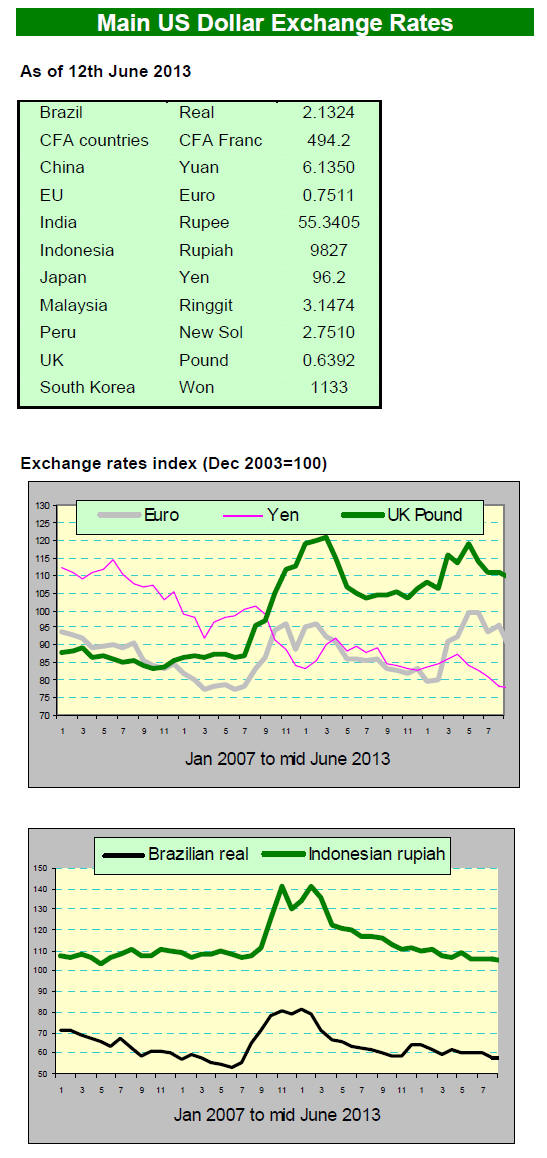Technical progress includes the development of a methodology to assess
private certification schemes and procedures for issuing legality
certificates, as well as the organisation of an independent audit.
With the EU Timber Regulation already in force but FLEGT licensing not
yet in place, Cameroon¡¯s timber producers and exporters must demonstrate
their compliance with the country¡¯s legal framework.
2. GHANA
Sawnwood exports generate bulk of first
quarter earnings
Ghana exported a total of 64,166 cu.m of wood products during the first
quarter of 2013 to earn Euro 29.48 million.
Compared to exports in the same period in 2012 there was a 4.6% increase in
export volumes and a 35% increase in export earnings in the first quarter
2013.
Exports of rotary veneer, boules, lumber (air and kiln dry), sliced veneer
and mouldings were the main driver of the increase in export earnings.
Exports of Air-Dry lumber (including overland exports) and Kiln-Dry lumber
together accounted for 47% of the total wood export volume for the first
quarter of the 2013.
Plywood exports were the second best performer accounting for 24% of the
total export volume. These three products together accounted for 68% (Euro
20.18 mil.) of the total value of exports for the quarter.

¡¡
EU remains main export market despite economic
downturn
Of the total Euro 29.48 million in export earnings from wood products in the
first quarter Europe emerged as the major destination accounting for 41% of
the trade. Imports by countries in Asia accounted for 25%, and this was
closely followed by imports by African countries at 23%.
Export of wood products from Ghana to ECOWAS countries for the period
Jan-Mar 2013 amounted to 17,558 cu.m compared to 26,204 cu.m recorded for
the same period in 2012.
Removal of fuel subsidy will lead to higher prices
From the 1 June the fuel subsidy was withdrawn and this, say analysts, will
result in price increases which will eventually have to be passed on to
consumers.
Ghana¡¯s budget deficit remains high and the Vice President, Kwesi Amissah-Arthur,
has said Ghana needs to renegotiate some resource contracts to increase tax
revenues and to give the country more fiscal room to maneuver.
May inflation highest in three years
Ghana's annual consumer price inflation rose to 10.9 percent in May, the
highest in three years.
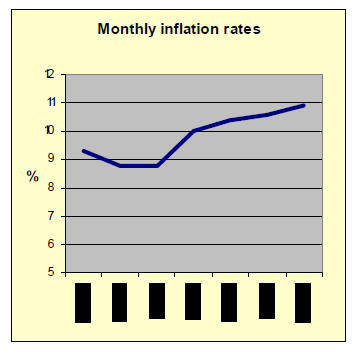
An increase in the annual rate of inflation from
10.6 percent in April was due to seasonal rises in the cost of education and
clothes and a scarcity of major food staples ahead of the next agricultural
harvest.


3. MALAYSIA
Malaysian Timber Council brochure sets
out scope of MYTLAS
The European Union (EU) Forest Law Enforcement, Governance and Trade
Voluntary Partnership Agreement (FLEGT VPA) is a mechanism to combat illegal
logging and facilitate trade in legal timber. The Malaysian government has
signalled its full support for this EU initiative and is in the final stages
of negotiation to conclude a FLEGT VPA.
Pending conclusion of negotiations for a FLEGT VPA with the EU, Malaysia
commenced implementation of a timber legality assurance scheme (TLAS)
designated as MYTLAS (Malaysia TLAS) on the 1February.
This is Malaysia¡¯s own initiative to assure the legality of its timber and
timber products exported to the EU. MYTLAS has also in place comprehensive
control procedures to ensure the exclusion of unverified timber.
A brochure for MYTLAS has been produced with
information on the scope of MYTLAS, its control procedures, institutional
arrangements and its implementation in Peninsular Malaysia.
The Malaysia Timber Council has said it is confident that MYTLAS meets the
requirements for due diligence on the part of EU importers under the EU
Timber Regulation.
For more information see:
www.mtc.com.my/issues/
Industry urged to consider species other than Acacia for plantations
Over the past weeks the timber industry in Malaysia was focused on the
Sarawak Grand Timber Expo and Conference 2013, held in Kuching in early
June. There were 112 exhibitors showcasing various products and the
conference attracted wide participation.
The Chief Minister of Sarawak, Abdul Taib Mahmud presented a keynote address
which touched on the policies and development objectives of the State.
Taib said forest plantations are fast approaching 20% of the permanent
forest area in the state and in the future these plantations should be able
to yield as much as presently harvested from around 80% of the natural
forests.
The species currently planted are fast growing but
he urged the industry to conduct more research on species other than Acacia
mangium.
By December 2012, Sarawak had 306,486 ha of tree plantations. Acacia is the
main species (comprising 72% of total), Batai 12%, Eucalyptus 7%, Kelampayan
6% and others 2% make up the balance.
However, to meet the state target of one million hectare of tree plantations
by year 2020 the industry has to plant 90,000 ha. a year.
Sarawak slow to supply international furniture market
Despite the steady export performance of the timber industry in the state
and generation of around RM7 bil. (appox. US$2.2 bil.) in export earnings a
year, Sarawak¡¯s Chief Minister has called on industry to take advantage of
the international demand for furniture.
He said ¡°Sarawak is not a big furniture producer and finds it hard to
compete in the world market against established players based in Peninsular
Malaysia¡±.
Peninsular Malaysia furniture exports close to value of all timber
exports from Sabah and Sarawak
In 2012, the total value of wood products exported from Malaysia was RM20.4
bil. (appox. US$6.4 bil.). The breakdown of exports from Peninsular
Malaysia, Sabah and Sarawak was; Peninsular Malaysia RM11.2 bil. (approx.
US$3.5 bil. with about half of that from furniture alone, Sabah RM1.8 bil.
(approx. US$564 mil.), and Sarawak RM 7.4 bil. (appox. US$2.32 bil.).
Asian destinations dominate Sarawak timber export trade
The major 2012 export markets for wood products from Sarawak were:

Wood products are the fourth largest source of
export earnings in Sarawak after liquefied natural gas, petroleum and palm
oil.
January to April export statistics for Sabah
The Department of Statistics in Sabah has released timber export statistics
for January to April 2013. In that period, Sabah exported 82,471 cu.m of
sawntimber worth RM123, 615,472 (appox. US$38.8 mil.).
In term of volume, 26.4% went to Thailand, 13% to each of Taiwan P.o.C and
China and 10.5% to South Africa.
Sabah exported 221,811 cu.m of plywood worth RM338,765,223 (appox. US$106.2
mil.).
In terms of volume 19% was shipped to Japan, 16% to Peninsular Malaysia,
12.5% to Egypt and almost 12% to the Democratic People¡¯s Republic of Korea.
Companies in Sabah also exported 11,735 cu.m of veneer worth RM17.1 mil. (appox.
US$5.4 mil.), 5,906 cu.m of mouldings, worth RM19.74 mil. (appox. US$6.2
mil.) and 17,407 cu.m of laminated boards, worth RM27.54 mil. (appox. US$8.7
mil).
¡¡
4. INDONESIA
Too many requirements in SVLK for
small manufacturers
Indonesia introduced a mandatory timber legality assurance scheme (SVLK) at
the beginning of this year and while many larger companies have secured the
required certification most small enterprises have not.
At a recent conference in Jepra a Programme Director of the
Multi-stakeholder Forestry Programme (MFP), Diah Raharjo, said that the
number of small enterprises that have the capacity to meet the requirements
of the SVLK is small.
The main problems for small industries is that first the process is
expensive and second the process is complicated and beyond the management
capacity of most small enterprises.
However, the major exporters are doing well and up to 3 June the value of
SVLK certified timber and wood product exports amounted to US$ 2,45 bil., up
from the US$ 2.06 billion as of 10 May.
The Indonesian License Information Unit of the Ministry of Forestry has
processed 31,724 export documents related to the US$ 2.45 bil.exports.
No decision yet on plantation log exports
The Secretary General of the Ministry of Forestry (MoF) has said that the
government has not decided on the issue of plantation log exports.
The Executive Director of APHI (Asosiasi Pengusaha Hutan Indonesia), the
association of Indonesian timber concession holders, Purwadi Soeprihanto is
urging the ministry to act decisively as the price of plantation logs the
domestic market is very low and opening a export trade in plantation logs
will bring multiple benefits to the forestry and wood processing sectors.
The potential for exports of Indonesian plantation timbers to Asian
countries such as China, Japan and South Korea is huge said Purwadi
Soeprihanto.
The MoF is moving cautiously on this issue and needs time to assess the risk
that a change in regulations could lead to illegal logging.
Government decision to revoke concessions only in legally recognised
customary forests raises concern
The government has said it would revoke the allocations to companies for
operations in customary forests. This comes after the Constitutional Court
annulled government ownership of customary forests.
The secretary general of the MoF said the government would withdraw all
plantation and mining concession allocations that have been granted in
customary forests that have been legally recognized by local
administrations.
This stance by the MoF has caused some concern as, currently, there is no
official data on the number of existing indigenous communities and the size
and territory of their customary land and forests.
However, a civil society group The Participatory Mapping Working Network (JKPP)
has documented 3.9 million hectares of indigenous land most of which is
forest.
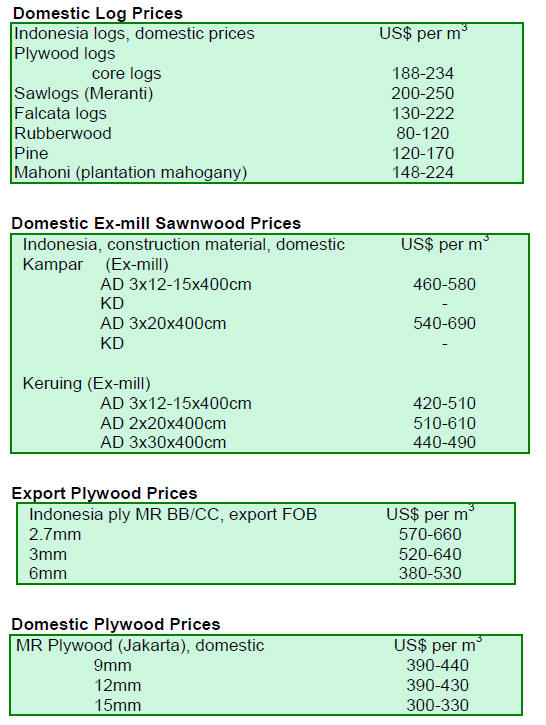

5. MYANMAR
Teak prices climb in advance of log
export ban
The following table illustrates the trend in teak log prices after the log
export ban was proposed in October 2012.
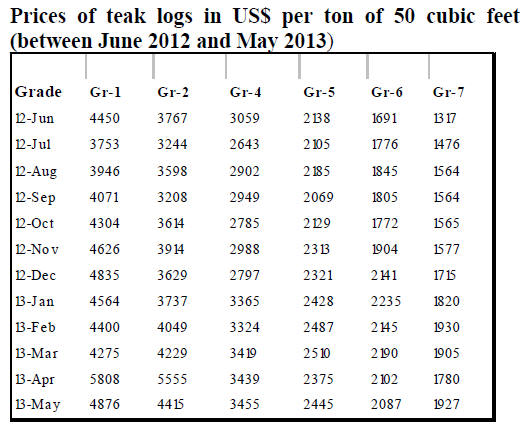
Overseas buyers holding high levels of teak
stocks
Analysts report that demand for teak logs is currently slow with India, the
main buyer, apparently unable to absorb any further shipments at present.
The market for pyinkado and gurjan is even quieter than that for teak.
With the log export ban due to come into force in April 2014, buyers in
India and Thailand are reportedly already heavily overstocked. Teak
shipments are moving slowly despite pressure from MTE on buyers to speed up
shipments of logs that have been purchased.
Some analysts suggest that, at the rate the logs are currently being
shipped, the log-stock in Yangon will not be moved before the log export ban
commences.
Under these circumstances there could be unshipped logs when the log export
ban comes into force but the MTE has not made public how it will deal with
unshipped logs.
Reforms in Myanmar can lead to vibrant market
economy
The World Economic Forum for East Asia was recently concluded in Nay Pyi
Taw, the capital of Myanmar. The forum was attended by executives and policy
makers from industry, government, academia and civil society from the around
the world.
The New Light of Myanmar newspaper reported on the opening speech by
President Thein Sein, in which he emphasised that the country is moving from
military rule towards democracy; to end armed conflicts and to reform the
economy to one based on free markets.
The Mizzima newspaper reported that in summing up the conclusions from the
World Economic Forum the meeting co-chairs agreed that Myanmar and the
Philippines are demonstrating the importance of driving reforms in response
to peoples¡¯ aspirations.
End May teak auction prices
The following prices were reported from competitive bidding for teak logs on
23rd and 27th May, the most recent Myanma Timber Enterprise tender.
¡¡
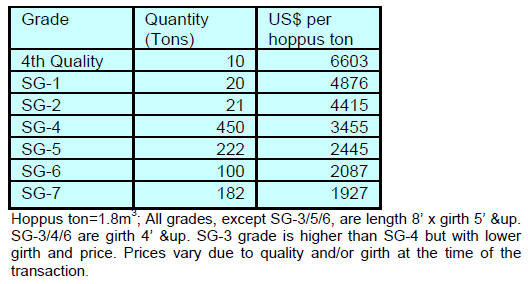
¡¡
6.
INDIA
Domestic teak log prices ease during
recent auction
In recently concluded auction sales at the government forest depots in
Jabalpur, Narmada Nagar and Raipur divisions of Central India, approximately
8,000 cubic metres of mainly teak and small quantities of haldu and laurel
were sold. Average prices for domestic teak logs per cubic foot, ex-depot,
are shown below.
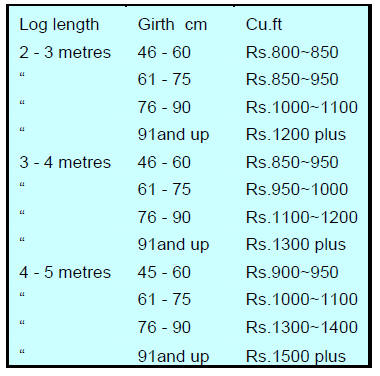
As the quality of the logs at these auctions was
below average and because buyers from Gujarat and Maharashtra were not
present, prices were lower than in the previous sale.
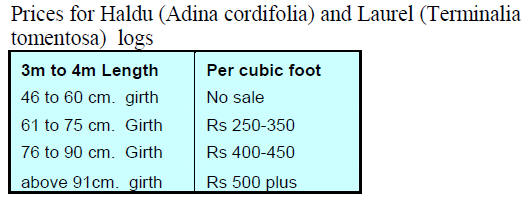
Plantation teak imports up five percent
Supplies and shipments of imported plantation teak have been maintained and
the volume of imports increased by 5% over the past month. Some minor price
changes have been reported.
Current prices for plantation teak C & F Indian ports, per cubic metre are
shown below.
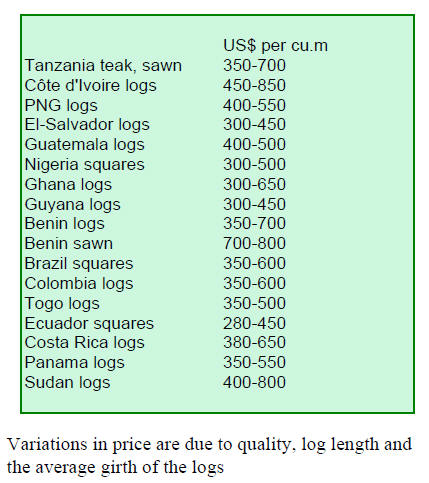
Imports of teak and other hardwoods
The volumes of teak and other sawn hardwood imports from April 2012 to March
2013 are shown below.
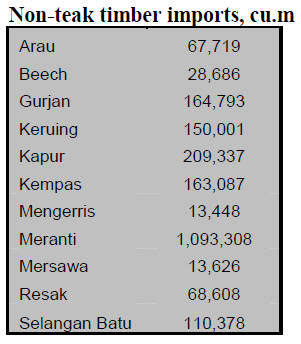
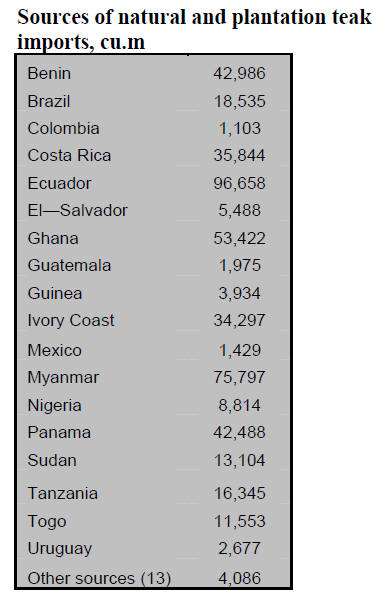
Domestic prices for sawnwood
The domestic prices for air dried sawnwood remained unchanged over the past
two weeks.
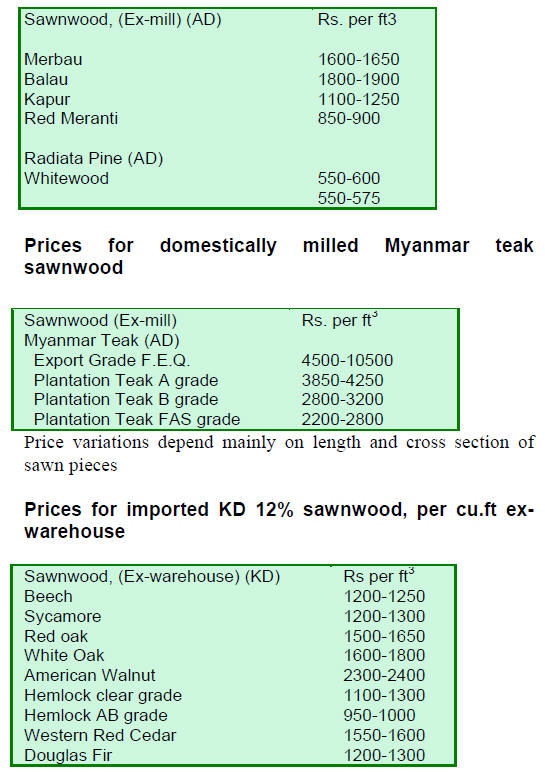
¡¡
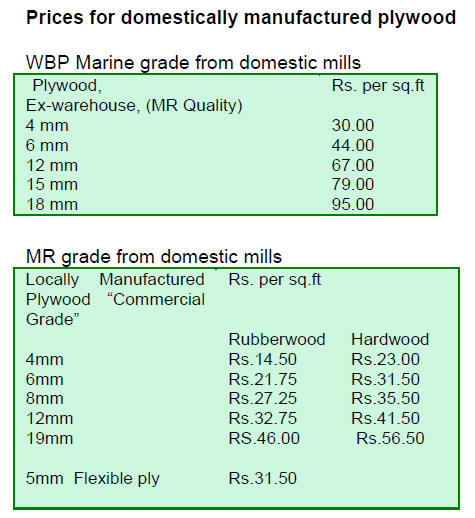
Study assesses effects of EU Timber Regulation
on industry in India
The EU FLEGT Facility has published a report that explores the potential
effects of the EU Timber Regulation and the growing demand for forest
certification on India¡¯s timber industry.
The study examines European companies¡¯ procurement policies and practices;
explores the implications of the EU Timber Regulation for the
competitiveness of India¡¯s timber products industry; and assesses the
measures that selected Indian companies and multinational corporations
operating in India are likely to take in response to changes in market
requirements.
The report suggests possible strategies for adoption by the Indian
government to mitigate the negative impacts of the changes.
The full report ¡°Effects of the EU Timber Regulation and the demand for
certified legal timber on business and industry in India¡± by T R Manoharan
can be downloaded at:
http://www.euflegt.efi.int/files/attachments/euflegt/india_eu_tr_study.pdf
The EFI summary of the report says:
¡°As of early 2013, India was not considering entering into a Voluntary
Partnership Agreement (VPA) under the EU Forest Law Enforcement, Governance
and Trade (FLEGT) Action Plan, largely because India has prohibited the
export of timber in the form of unprocessed logs.
The export of timber products from India, however, is not only permitted but
is actively encourage d by the government and is growing.
The EU, India¡¯s largest overall international trade partner, is a major
market for India¡¯s semi-processed and value-added timber products, including
wooden handicrafts, pulp and paper, plywood and veneer, and wooden
furniture.
India¡¯s timber products industry is therefore
likely to be affected by the introduction of the EU Timber Regulation (EUTR),
which came into force on 3 March 2013.
For India, products listed under the EUTR have an annual export value of
around US$1.3 billion, and in 2012, six EU Member States accounted for more
than 12% of this total value.
Furthermore, India¡¯s exports of value-added timber and timber products to
the EU and other markets are increasing, with these products manufactured
from both domestically sourced and imported timber.¡±
JICA support for livelihood development project
The forest department of Jharkhand has prepared a Project on the Advancement
of Livelihood and Forestry for Ecological Security (Palash) which has been
submitted to the Japan International Cooperation Agency (JICA).
A national level deliberation took place in Ahmedabad in early May and
officials of the central government¡¯s Ministry of Environments and Forestry,
as well as officials from 13 states, including Jharkhand participated.
The focus of the project is development of the livelihood of people living
within or on the fringe of forest areas.
It has been proposed that the project be funded through a soft loan over a
period of 40 years. JICA has funded such projects in India since 1991. The
first phase of JICA funded work in India was from 1991-2001, the second from
2002-2012 and the third, beginning from 2013 will stress livelihood and
sustainability of forestry projects.
¡¡
7.
BRAZIL
Changes in licensing system aids
joinery sector in Acre
In 2011, the government of Acre introduced measures to create more
opportunities for the joinery sector in the state with the aim of improving
the contribution of the sector to the local economy.
This initiative, through the ¡®Program for Strengthening the Timber Sector¡¯,
focused on licensing all joinery makers in the state.
There are around 350 joiners in Acre but before the new support programme
only 10% were licensed. The major hurdle to licensing was the difficulty in
securing the required ¡®environmental¡¯ license a process which was hampered
by bureaucracy and was also costly.
In the past, joiners had to travel to one of governmental offices of the
Institute of Environment of Acre (IMAC) in Cruzeiro do Sul or Rio Branco,
the state capital, to get the license.
In order to address this issue the state government took the initiative and
went directly to the joiners and assisted them in securing the required
environmental license. Today, out of 350 joiners in Acre, 90% are licensed.
The legalisation of the joiners has brought some benefits. Now the state
government can purchase its joinery requirements from local industry rather
than having to buy from licensed producers in other states.
After the licensing of joiners the state government began a programme to
advise manufacturers to only purchase raw material coming from managed
forests. This programme was conducted in cooperation with the Timber Workers
Union.
Bidding opens for forest concession in Para
At the end of May the Brazilian Forest Service (SFB) launched bidding for
forest concession in the Crepori National Forest (FLONA) in Par¨¢ state.
The concession area is divided in four management units of 29,000 ha.,
59,800ha, 134,000 ha and 219,000ha, in order to satisfy the needs of
different sized companies.
Companies interested in bidding had to submit documentation proving its
capacity as well as technical and pricing proposals. The minimum price for
bidding is R$16,38 per cubic metre which was established on the basis of
market values and to ensure an internal rate of return compatible with other
investment options.
The structure of the technical proposal had to focus on those environmental,
social and economic indicators that would contribute to expansion of the
benefits to be generated through management of the concession.
Companies that win concession contracts will receive the right to manage the
areas for logging and extraction of non-timber forest products for up to 40
years. The concessionaires will enjoy a number of mechanisms that reduce
transaction costs and encourage improvement of the social and environmental
performance of the undertaking.
Among these new mechanisms is the expansion of the ¡°bonus¡± mechanism through
which discounts are given based on the achievement of quality indicators
established in the agreement.
Phytosanitary regulations reviewed to facilitate log exports to China
The strong demand for raw materials in China is seen as an opportunity for
Brazilian exporters especially those marketing sawnwood as well as producers
of pine and eucalyptus logs.
The tropical main species of interest to China at the moment are jatob¨¢ (Hymenaea
courbaril), cedro (Cedrela sp.), cabreuva (Myrocarpus frondosus), angelim (Hymenolobium
sp), itaub¨¢ (Mezilaurus itauba), tauari (Couratari), ip¨º (Tabebuia spp),
cumaru (Dipteryx odorata) and sucupira (Bowdichia n¨ªtida).
¡¡
Pine from Brazil is well accepted in the Chinese
market but eucalypt is of less interest, partly because China imports large
quantities from South Africa.
The Ministry of Agriculture, Livestock and Food Supply (MAPA) and the
Integrated Agricultural Development Company (CIDASC) are looking for ways to
facilitate the export of pine logs with bark to China where strict
phytosanitary rules are in force.
Representatives of International Agricultural Inspection System of MAPA and
the Plant Health Protection Service and CIDASC Regional Administration of
Itaja¨ª municipality met recently to discuss adjustments to the regulations
for issuance of phytosanitary certificates to allow for the export of pine
logs with bark.
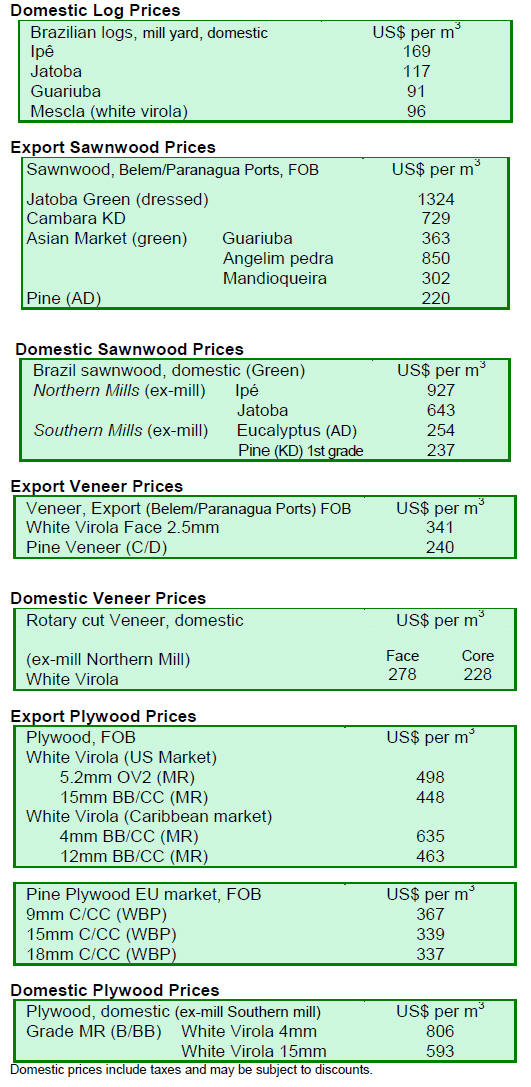
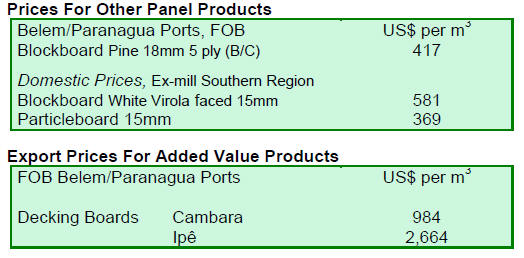
¡¡
8. PERU
Expo Amazonica 2013 scheduled for
August
Expo Amazonica 2013 will be held from 10th to 31st August this year in the
city of Iquitos and is expected to generate business worth around US$15
million for businesses in the Amazon region of the country. The purpose of
the event is to promote private investment and business development in the
Amazon region and wood products feature prominently in the expo.
It has been reported that, as of May, fourteen international delegations
will attend including from Brazil, Bolivia, Colombia, Spain, Mexico,
Venezuela, China and the United States. The expo is expected to attract
around 400 exhibitors and 30,000 visitors.
Amazonian people present their own vision on REDD +
Edwin V¨¢squez Campos, from Coordinadora de las Organizaciones Ind¨ªgenas de
la Cuenca Amaz¨®nica (COICA) an organisation that coordinates action by nine
national Amazonian indigenous organizations has presented the views of
Amazonian indigenous people on mechanisms related to Reducing Emissions from
Deforestation and Degradation (REDD +).
At a side event at the headquarters of the United Nations in New York he
said that ¡°REDD + Indigenous Amazonian (RIA)¡± has the same goal of reducing
emissions but with a different strategy that placed priority on a long-term
¡®life plan¡¯ for Amazonian peoples.
The vision of COICA, said V¨¢squez Campos, is the holistic management of
forests to integrate mitigation and adaptation, climate change and
biodiversity.
He described the proposed Indigenous REDD + as having three main components:
strengthening ecosystem functions through a management or holistic
management of indigenous territories, reducing the overall footprint and
eliminating the drivers of deforestation in the Amazon.

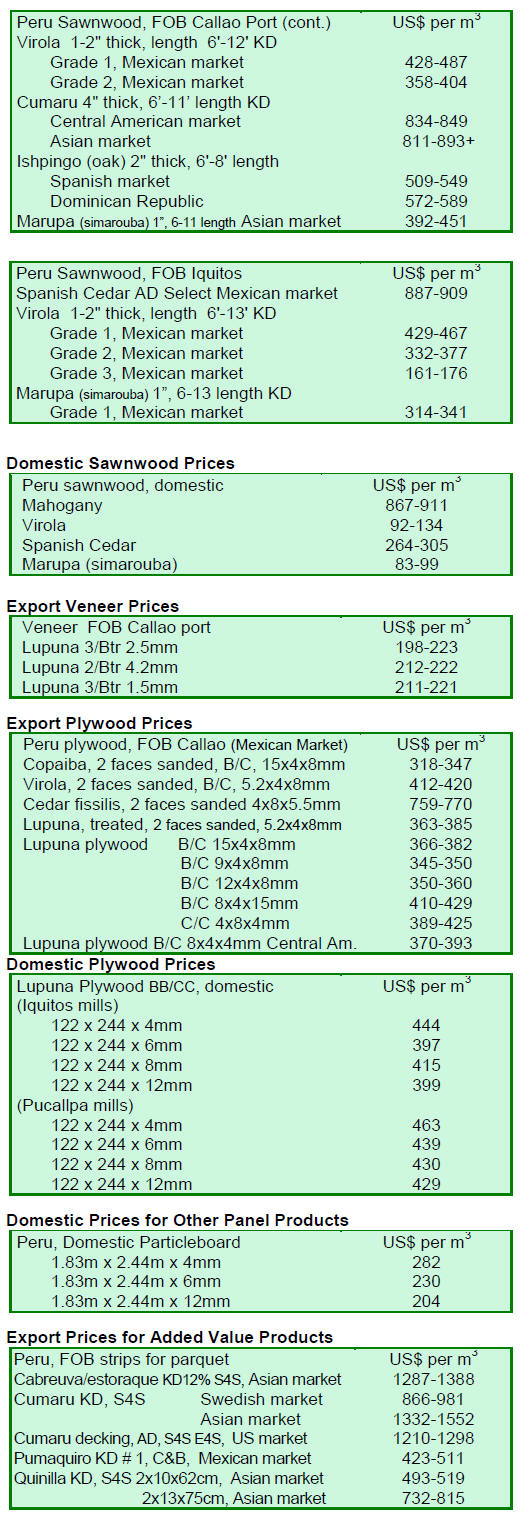
9.
GUYANA
Log exports resume and prices climb
During the later part of May log exports resumed. Greenheart log export
prices were fair for both standard and fair sawmill quality logs.
Prices for all categories of purpleheart logs were exceptional last month
with Standard Sawmill Quality top end prices rising to as much as US$380 per
cubic metre FOB.
This was closely followed by prices for purpleheart Fair Sawmill Quality
logs which attracted a price of US$295 per cubic metre FOB. Small Sawmill
Quality purpleheart logs earned a price of US$245 per cubic metre FOB.
Mora log exports also made a noteworthy contribution to export earning with
good prices posted for the Fair and Small Sawmill Qualities. Asian markets
were the major destination for these top class durable timbers from Guyana.
Japanese buyers seek dressed greenheart
During the period reviewed sawnwood exports were encouraging earning
favourable market prices for both rough sawn and dressed categories.
Undressed greenheart sawnwood earned a significantly high top end FOB price
of US$1,357 per cubic metre towards the end of May while merchantable
Sawmill Quality logs only managed to sustain a price of US$551 per cubic
FOB. The main market for sawn greenheart was Europe and the Caribbean and
this timber is popular in both markets.
In sharp contrast, Undressed purpleheart sawnwood FOB prices fell slightly
from US$1,251 to US$1,100 per cubic metre. Sound Quality purpleheart
sawnwood was priced at US$594 per cubic metre FOB.
Undressed mora sawnwood exports also performed well with both Select and
Merchantable Quality timbers fetching US$575 and US$595 per cubic metre FOB
respectively.
Prices for Dressed greenheart sawnwood recorded a significant increase in
top end price from US$1,187 to US$ 1,500 per cubic metre FOB for the
Japanese market. Dressed purpleheart FOB prices improved from US$806 to
US$1,102 per cubic metre.
Caribbean plywood market picks up after a lull
The plywood market was active and prices for Utility grade plywood improved.
On the other hand, export prices for BB/CC quality remained unchanged.
Utility grade plywood has not been traded for some time but recently has
attracted interest from buyers. Prices for Utility grade boards are in the
region of US$769 per cubic FOB in the Caribbean and South American markets.
Exports include products from high value species
Splitwood (shingles) continues to attract favourable prices on the export
market in the region of US$955 per cubic metre FOB with the Caribbean the
primary market.
Roundwood (greenheart piles) also attracted favourable prices on the export
market earning US$569 per cubic metre, with North America and Europe the
main destination.
Also, exports of wallaba posts made a noteworthy contribution to earnings
attracting prices as high as US$600 per cubic metre FOB in the Caribbean
markets.
A variety of added value products were traded including doors, indoor and
outdoor furniture, mouldings, spindles and window frames. Some of Guyana¡¯s
primary species such as crabwood (andiroba) locust (jatoba) and purpleheart
are utilised in producing some of these high value products.
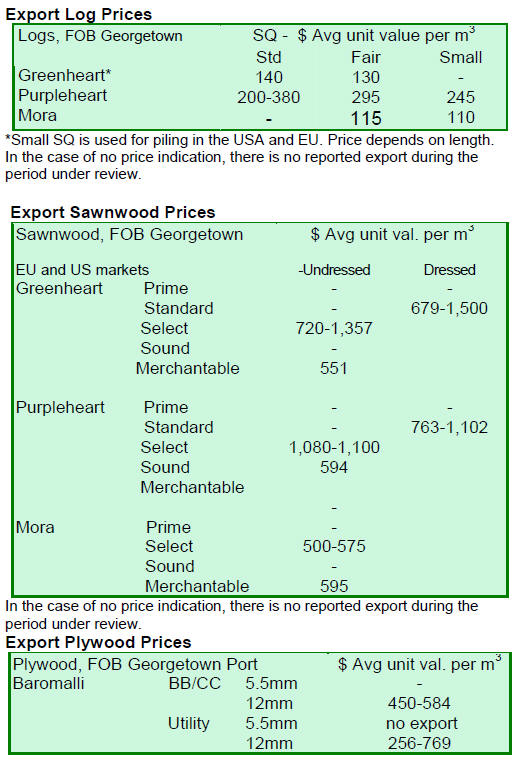
¡¡
